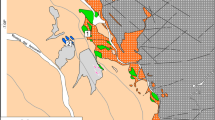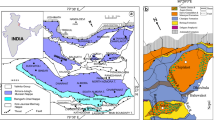Abstract
The Yuksipryong granite is a medium-to coarse-grained leucocratic granite, which contains two micas. It belongs to peraluminous granite and has primary muscovite as aluminous minerals. Biotite of the Yuksipryong granite has an average FeO*/MgO ratio of 3.7 and 6–7 wt% MgO, which is in accordance with those from the other peraluminous granite. However, biotite has low Mg/(Fe+Mg) ratio with an average of 0.37 and low aluminum content as compared to siderophyllitic biotites occurring in the typical peraluminous two mica suites. It contains substantial octahedral site vacancy probably due to the substitution of 3M2+VI⇔2AlVI, □VI, suggesting lower temperature crystallization compared with ideal trioctahedral biotite—eastonite compositions.
On the basis of petrographic observation, the muscovite in Yuksipryong two-mica granite can be classified into six types on the basis of textural criteria: (1) occurring as intergrowth with or across biotite filling the interstices or as overgrowth of other minerals, (2) as euhedral crystals including small biotite, (3) as single euhedral to subhedral crystals without inclusions, (4) as subhedral crystal within plagioclase, (5) as lath-shaped crystals, and (6) in pegmatitic dyke, occurring as a single large subhedral crystal. According to the textural evidence and chemical compositions of muscovite, types 1, 2, 3, and 4 belong to primary muscovite. Thus, muscovite in Yuksipryong granite is considered to be mostly primary muscovite formed at the magmatic stage. Primary muscovite contains significant magmatic muscovite, however, sodium and silicon contents show wide variations in all types. Muscovite shows celadonite or tschermark subsitutions: R3++AlIV=Si+R2+(R3+=Al, Fe and R2+=Mg, Mn).
Considering the composition of micas together with the experimental results of many workers, the biotite and the primary muscovite of Yuksipryong granite are considered to have been crystallized at pressures higher than 3.5 kbar and temperatures between 700–750°C.
Similar content being viewed by others
References
Abdel-Raham, A.M., 1994, Nature of biotites from alkaline, calcalkaline and peraluminous magmas. Journal of Petrology, 35, 525–541.
Abdel-Raham, A.M., 1996, Discussion on the comment on nature of biotites in alkaline, calc-alkaline and peraluminous magmas. Journal of Petrology, 37, 1031–1035.
Anderson, J.L. and Rowley, M.C., 1981, Synkinematic intrusion of peraluminous and associated metaluminous granitic magma, Whipple Mountains, California. Contributions to Mineralogy and Petrology, 19, 83–101.
Barbarin, B., 1990, Granitoids: Main petrogenetic classifications in relation to origin and tectonic setting. Geological Journal, 25, 227–238.
Barbarin B., 1996, Genesis of the two main types of peraluminous granitoids, Geology, 24, 295–298.
Choo, S.H., 1986, Rb−Sr age determinations on the Ryeongnam Massif (III), Report KR-86-2-17, Korea Institute of Energy and Resources, Taejon, Korea, 1–28.
Clarke, D.B., 1981, The mineralogy of peraluminous granites: A review. Canadian Mineralogist, 19, 3–18.
Conard, W.K., Nicholls, I.A. and Wall, V.J., 1988, Water-saturated and-undersaturated melting of metaluminous and peraluminous crustal compositions at 10 kb: Evidence for the origin of silicic magmas in the Taupo volcanic zone, New Zealand, and other occurrence. Journal of Petrology, 29, 765–803.
de Alquerque, C.A.R., 1973, Geochemistry of biotites from granitic rocks, northern Portugal. Geochimica et Cosmochimica Acta, 37, 1779–1802.
Deer, W.A., Howie, R.A. and Zussman, J., 1992, An introduction to the rock-forming minerals (2nd ed.), Longman Science and Technical, New York, 696 p.
Guidotti, C.V., 1978, Muscovite and K-feldspar from two-mica adamellite in northwestern Maine: Composition and petrogenetic implications. American Mineralogist, 63, 750–753.
Hibbard, M.J., 1995, Petrography to petrogenesis. Prentice Hall, 216 p.
Hong, S.H. and Yun, W., 1993, Geological report of the Changkye sheet (1∶50,000). Korea Institute of Geology, Mining and Materials, Taejon, 1–7.
Jwa, Y.J., 1997, Petrological characteristics of two-micas granites: Example from Cheongsan, Inje—Hongcheon, Yeongju and Namwon areas. The Journal of the Petrological Society of Korea, 6, 210–225. (in Korean with English abstract)
Kerrick, D.M., 1972, Experimental determination of muscovite+quartz stability with PH 2O<Ptotal American Journal of Science, 272, 946–958.
Kim, C.B. and Kim, Y.J., 1990, Geochronology and petrochemistry of foliated granites between Damyang and Jinan. The Journal of the Korean Institute of Mining Geology, 23, 233–244. (in Korean with English abstract)
Kim, Y.J., Cho, D.L. and Park, Y.S., 1989a, K−Ar ages and major mineral compositions of the Mesozoic igneous rocks in the vicinity of the Geochang area. The Journal of the Korean Institute of Mining Geology, 2, 117–127. (in Korean with English abstract)
Kim, Y.J., Park, Y.S., Choo, S.H. and Oh, M.S., 1989b, The study in the igneous activity in the southeastern zone of the Ogchen geosynclinal belt, Korea (I): with the igneous activity in Namweon-Geochang-Sangju area. The Journal of the Korean Institute of Mining Geology, 22, 355–370. (in Korean with English abstract)
Kim, Y.J., Lee, C.S. and Kang, S.W., 1991, Petrochemistry on inter-mediated-basic plutons in Jirisan area of the Ryeongnam Massif. The Journal of the Korean Earth Science Society, 12, 100–122. (in Korean with English abstract)
Koh, J.S. and Yun, S.H. 1997, Petrological study on the Yuksipryong two-mica granite. 36th Annual Meeting of the Korea Society of Economic and Environmental Geology, Kwangju, 98pp., 64. (in Korean)
Kwon, S.-T. and Hong, S.S., 1993, Contrasting TiO2/MgO ratio in the Namweon graitic complex. The Journal of the Petrological Society of Korea, 1, 41–52.
Le Breton, N. and Thompson A.B., 1988, Fluid-absent (dehydration) melting of biotite in metapelites in the early statges of crustal anatexis. Contributions to Mineralogy and Petrology, 99, 226–237.
Lee, D.E., Kistler, R.W., Friedman, I. and Loenen, R.E.V., 1981, Two-mica granites of northeastern Nevada. Journal of Geophysical Research, 86, 10607–10616.
Miller, C.F., Stoddard, E.F., Bradfish, L.J. and Dollase, W.A., 1981, Composition of plutonic muscovite: genetic implications Canadian Mineralogist, 19, 25–34.
Monier, G. and Robert, J.L., 1986, Muscovite solid solutions in the system K2O−MgO−FeO−Al2O3−SiO2−H2O: An experimental study at 2 kbar PH 2O and comparison with natural Li-free white micas. Mineralogical Magazine, 50, 257–266.
Oretega, L.A. and Gil-Ibarguchi, J.I.G., 1990, The genesis of late Hercynian granitoids from Galicia (northwestern Spain): Interences from REE studies. Journal of Geology, 98, 189–211.
Pantino Douce, A.E., 1993, Titanium substitution in biotite: An empirical model with applications to thermometry, O2 and H2O barometries, and consequences for biotite stability. Chemical Geology, 108, 133–162.
Park, J.B., Kim, Y.J. and Kim, C.B., 1990, Petrochemical study on igneous rocks in the Hamyang area, Kyongnam, Korea. The Journal of the Korean Institute of Mining Geology, 23(1), 105–123, (in Korean with English abstract)
Park, Y.S., Park, C.Y., Kim, J., Ryu, J.S. and Kim, Y.J., 1996, Rb−Sr & Sm−Nd isotopic on the granitoids in the Namweon area. The Korean Institute of Mineral and Energy Resources Engineers, 33, 40–60. (in Korean with English abstract)
Puziewicz, J. and Johannes, W., 1988, Phase equilibrium and compositions of Fe−Mg−Al minerals and melts in the water-saturated peraluminous granitic systems. Contributions to Mineralogy and Petrology, 100, 156–168.
Speer, J.A., 1984, Micas in igneous rocks. In: Bailey, S.W. (ed), Reviews in Mineralogy, volume 13, Micas. Mineralogical Society of America, 229–356.
Stussi, J.M. and Cuney, M., 1996, Nature of biotite from alkaline, calc-alkaline and peraluminous magmas (by Abdel-Fattah M. Abdel-Rahman): A comment. Journal of Petrology, 37, 1025–1029.
Swanson, S.E., 1977, Relation of nucleation and crystal growth rate to the development of granitic textures. American Mineralogist, 62, 966–978.
Thomson, A.B., 1982, Dehydration melting of pelitic rocks and the generation of H2O-undersaturated granitic liquids. American Journal of Science, 282, 1567–1595.
Tracy, R.J., 1978, High grade metamorphic reactions and partial melting in pelitic schist, westcentral Massachusetts. American Journal of Science, 278, 150–78.
Veld, B., 1967, Si+4 content of mature phengites. Contributions to Mineralogy and Petrology, 14, 250–258.
Vielzeuf, D. and Holloway, J., 1988, Experimental determination of the fluid-absent melting relations in the pelitic system: Consequences for crustal differentiation. Contributions to Mineralogy and Petrology, 98, 257–276.
White, A.J.R., 1989, Commentaries on the significance of cordierite and muscovite in peraluminous felsic magmas. EOS (Transactions, American Geophysical Union), 70, 11–111.
White, A.J.R. and Chappell, B.W., 1988, Some supracrustal (S-type) granites of the Lachlan Fold Belt. Transactions of Royal Society of Edinburgh, Earth Science, 79, 169–181.
Zen, E-an, 1989, Commentaries on the significance of cordierite and muscovite in peraluminous felsic magmas. EOS (Transactions, American Geophysical Union), 70, 109–110.
Author information
Authors and Affiliations
Rights and permissions
About this article
Cite this article
Koh, J.S., Yun, S.H. The compositions of biotite and muscovite in the Yuksipryong two-mica granite and its petrological meaning. Geosci J 3, 77–86 (1999). https://doi.org/10.1007/BF02914263
Received:
Accepted:
Issue Date:
DOI: https://doi.org/10.1007/BF02914263




